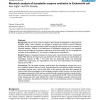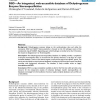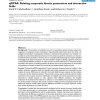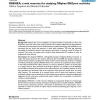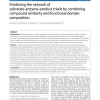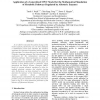PROCEDIA
2010
13 years 10 months ago
2010
One of the greatest challenges in computational chemistry is the design of enzymes to catalyze non-natural chemical reactions. We focus on harnessing the distributed parallel comp...
BMCBI
2004
14 years 3 months ago
2004
Background: The two most common models for the evolution of metabolism are the patchwork evolution model, where enzymes are thought to diverge from broad to narrow substrate speci...
BMCBI
2005
14 years 3 months ago
2005
Background: Dehydrogenase enzymes belong to the oxidoreductase class and utilise the coenzymes NAD and NADP. Stereo-selectivity is focused on the C4 hydrogen atoms of the nicotina...
BMCBI
2007
14 years 3 months ago
2007
Background: The simulation of metabolic networks in quantitative systems biology requires the assignment of enzymatic kinetic parameters. Experimentally determined values are ofte...
BMCBI
2006
14 years 3 months ago
2006
Background: The number of sequences compiled in many genome projects is growing exponentially, but most of them have not been characterized experimentally. An automatic annotation...
BMCBI
2006
14 years 3 months ago
2006
Background: Despite the current availability of several hundreds of thousands of amino acid sequences, more than 36% of the enzyme activities (EC numbers) defined by the Nomenclat...
BMCBI
2010
14 years 3 months ago
2010
Background: Metabolic pathway is a highly regulated network consisting of many metabolic reactions involving substrates, enzymes, and products, where substrates can be transformed...
BMCBI
2010
14 years 3 months ago
2010
Background: PCR-restriction fragment length polymorphism (RFLP) assay is a cost-effective method for SNP genotyping and mutation detection, but the manual mining for restriction e...
CSB
2005
IEEE
14 years 5 months ago
2005
IEEE
In our effort to elucidate the systems biology of the model organism, Escherichia coli, we have developed a mathematical model that simulates the allosteric regulation for threoni...

